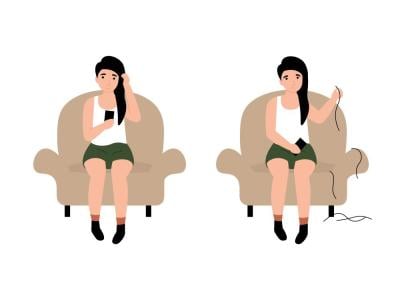How to Stop Pulling or Picking
How to Stop Pulling or Picking

Just stop pulling or picking!
If only it were that simple.
Compulsive hair pulling (trichotillomania) and skin picking (excoriation) are Body Focused Repetitive Behavior Disorders (BFRBs). If you’re one of the 200+ million people who live with a BFRB, then you know how incredibly difficult these habits are to stop.
Not impossible, though. You just have to know a little more about how these compelx habits work so that you can find the right management strategies.
Understanding Habits
The basic anatomy of a habit is: trigger or cue -> habit behavior -> reward.
The trigger or cue is what starts the whole chain of events. Think of it as a spark that activates an urge.
The habit is the repetitive behavior or series of behaviors that runs on autopilot.
Habits are reinforced, meaning they get engrained and keep happening, because they lead to some sort of reward.
When it comes to BFRBs, the habit is the repetitive body-focused behavior like picking, biting, chewing, pulling, or scraping of the hair or skin. The reward that follows is typically some sort of satisfaction – it feels good to pull or pick – or relief from something unpleasant – the bothersome hair or spot is removed or it helps calm down stress or anxiety.
Identifying the triggers or cues is where it gets a little more complicated.
Why Do People Pull or Pick?
BFRBs are complex, and not everyone has the same habit anatomy. That is, different people pull or pick for different reasons.
Some people with BFRBs don’t realize they’re engaging in their habit. It’s like their hands have a mind of their own. For others, the behavior is intentional. It is done with full awareness, though it may not feel volitional or controllable. And still others experience both mindless and deliberate pulling or picking.
The urge to pull or pick can be triggered by a variety of factors. I use the acronym STEAM to remember them.
S = Sensory input. Most commonly, this is seeing or feeling a bothersome hair or piece of skin or nail. That visual or tactile input triggers the urge.
T = Thoughts. Thoughts like “It’s not perfect.” “It’ll feel good.” “I can’t handle this being there.” And “That hair/skin has to go” can all lead to urges to pull or pick.
E = Environment. Sometimes it’s the location (like being in the car, in bed, or watching TV) that triggers the urge.
A = Affect. This is a fancy term for emotion. Feelings like anxiety and boredom can trigger urges to pull or pick.
M = Muscle memory. Sometimes urges get started because your arm or hand is in the same position as when you typically pull or pick. For example, resting your temple on your fist may quickly lead to pulling hair from your scalp because your arm is in the same position.
Selecting Strategies to Help You Stop
Understanding the anatomy of a habit gives you valuable insight you can use to help break the cycle.
When it comes to BFRBs in particular, paying attention to what triggers your urges to pull or pick can help you identify which strategies might be useful for preventing urges from happening or being able to ride them out when they do. For example, barriers (like wearing gloves or some sort of finger covers, nail polish, or a hat) are a popular strategy. They can be really effective, especially for mindless pulling or picking that is triggered by environment, sensory, or muscle memory cues…not so much if your urges are triggered by thoughts. In that case, working on reframing your thinking is going to be more useful.
Replacing the habit behavior might also be helpful. For example, if your BFRB is triggered by emotions like anxiety or boredom, you might find success in developing other anxiety management techniques like deep breathing or mindfulness or fidgeting with your hands during boring tasks.
Finding ways to replicate the reward may also help break the habit cycle. For example, if the habit tends to provide satisfaction, experimenting with alternatives like pulling fibers from a carpet square, manipulating certain fidgets, popping bubble wrap, or pulling strings from celery may do the trick.
The bottom line is that taking the time to analyze your habit so that you can identify the triggers (STEAM factors) and the rewards that reinforce it is well worth your time. Then, equipped with that information, you can start to experiment with a variety of strategies until you land on the ones that work for you.

















